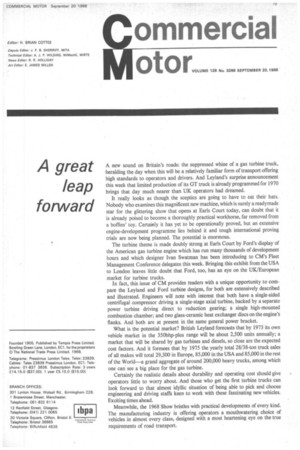A great leap forward
Page 83

If you've noticed an error in this article please click here to report it so we can fix it.
A new sound on Britain's roads: the suppressed whine of a gas turbine truck. 'heralding the day when this will be a relatively familiar form of transport offering high standards to operators and drivers. And Leyland's surprise announcement this week that limited production of its UT truck is already programmed for 1970 brings that day much nearer than UK operators had dreamed.
It really looks as though the sceptics are going to have to eat their hats. Nobody who examines this magnificent new machine, which is surely a readymade star for the glittering show that opens at Earls Court today, can doubt that it is already poised to become a thoroughly practical workhorse, far removed from a boffins' toy. Certainly it has yet to be operationally proved, but an extensive engine-development programme lies behind it and tough international proving trials are now being planned. The potential is enormous.
The turbine theme is made doubly strong at Earls Court by Ford's display of the American gas turbine engine which has run many thousands of development hours and which designer Ivan Swatman has been introducing to CM's Fleet Management Conference delegates this week. Bringing this exhibit from the USA to London leaves little doubt that Ford, too, has an eye on the UK/European market for turbine trucks.
In fact, this issue of CM provides readers with a unique opportunity to compare the Leyland and Ford turbine designs, for both are extensively described and illustrated. Engineers will note with interest that both have a single-sided centrifugal compressor driving a single-stage axial turbine, backed by a separate power turbine driving direct to reduction gearing; a single high-mounted combustion chamber; and two glass-ceramic heat exchanger discs on the engine's flanks. And both are at present in the same general power bracket.
What is the potential market? British Leyland forecasts that by 1973 its own vehicle market in the 350bhp-plus range will be about 2,500 units annually; a market that will be shared by gas turbines and diesels, so close are the expected cost factors. And it foresees that by 1975 the yearly total 28/38-ton truck sales of all makes will total 29,300 in Europe, 85,000 in the USA and 85,000 in the rest of the World—a grand aggregate of around 200,000 heavy trucks, among which one can see a big place for the gas turbine.
Certainly the realistic details about durability and operating cost should give operators little to worry about. And those who get the first turbine trucks can look forward to that almost idyllic situation of being able to pick and choose engineering and driving staffs keen to work with these fascinating new vehicles. Exciting times ahead.
Meanwhile, the 1968 Show bristles with practical developments of every kind. The manufacturing industry is offering operators a mouthwatering choice of vehicles in almost every class, designed with a most heartening eye on the true requirements of road transport.


















































































































































































































































































































































































